Gladiolus, like most blousy blooms, went out of fashion for a while. But, just like Dahlias and Hollyhocks, they’re back with a boom. Learn how to grow the perfect gladiolus for cut flowers and ornamental borders with Aussie Green thumb.
We’ve got all the tips and tricks to grow gorgeous gladiolus; from the perfect gladiolus fertiliser, to the best propagation methods. You’ll be growing these stunning blooms from corms in no time, and have an enviable summer display if you plan ahead in fall or early spring.
More...
Family: | Iridaceae |
|---|---|
Genus: | Gladiolus |
Species: | various |
Common Names: | Sword Lily |
Location: | Outdoor |
Type: | Herbaceous perennial |
Growth: | (H) 1m x (W) 30cm |
Sun requirements: | Full sun |
Foliage Colour: | Green |
Flower Colour: | Pink, orange, yellow, red, white, purple |
Flowering: | Summer |
Fruit: | None |
Maintenance level: | High |
Poisonous for pets: | Toxic to cats and dogs |
What is Gladiolus?
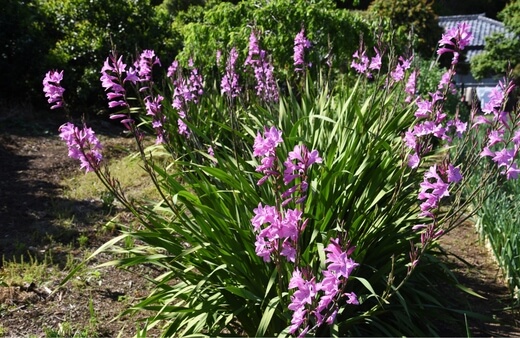
Gladioli, or sword lily to give them their common name, are a genus of flowering, cormous plants closely related to Iris, and part of the same plant family (Iridaceae). Cormous plants grow from corms, short, flat bulbs which can be hard to understand due to the similarities between the root plate and the tip, particularly when dry.
Most Gladioli species flower on a single spike, with flowers appearing in sequence, but proper feeding, and support can help to create perfect spikes of flowers that all display at the same time, for a high-impact border.
Gladioli’s Natural Habitat
Gladioli are native to Asia, the Mediterranean, and tropical Africa, but are most associated with South Africa and the Cape Floristic Region where they thrive and grow in swathes through meadows and on hillsides.
Originally, gladioli were pollinated solely by long-tongued bees, but modern evolution has seen them adapt well to pollination by moths, small birds and long-tongued flies making them incredibly useful for Australian gardeners hoping to encourage diverse pollinators into the garden.
The Best Gladioli to Grow in Australia
1. Gladiolus ‘Black Pearls’As well as being reliably tall, and flowering for longer than most gladiolus, Black Pearl has gorgeous burgundy flowers, and often up to three huge flower spikes per plant, which bloom together, and can be extended by deadheading. If you can fit such rich colour into your borders without it clashing, there is no better, or easier gladiolus to grow. | 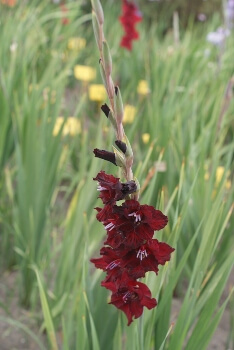 Source: commons.wikimedia.org |
2. Gladiolus alatusGladiolus alatus is a true species of gladiolus, found naturally in South Africa on the Cape Peninsula, where it benefits from sea breezes and hot summers, growing freely in grasslands. Its deep, zesty, orange petals stand proudly over an acid-yellow basal petal to attract bees and pollinators to its open blooms. | 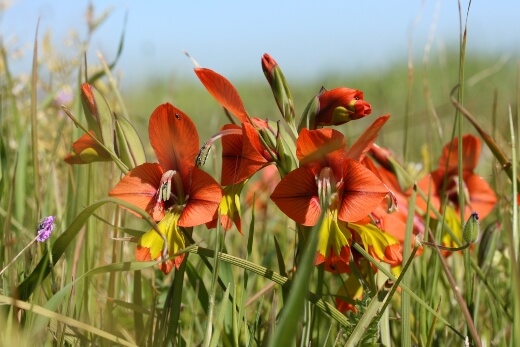 Source: en.wikipedia.org |
3. Gladiolus communis subsp. byzantinusThe violet petals of G. communis subsp. byzantinus pop even brighter thanks to the silvery foliage and delicate stems, which raise these glorious blooms well above the rest of the garden, floating perfectly when nestled in amongst a frothy backdrop of Verbena bonariensis. |  Source: southernbulbs.com |
4. Gladiolus ‘Priscilla’As one of the most popular Gladioli cultivars, Priscilla has an obvious blousiness that is often associated with the gardens of the 1980s. For me though, that nostalgia adds to its charm, with creamy blooms, tipped with a delicate jammy pink, and a sugary yellow centre to each flower. It would challenge any gardener not to salivate at the sight of these luxurious blooms. | 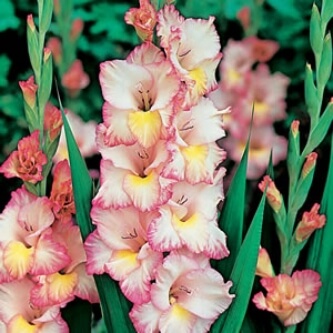 Source: gardenexpress.com.au |
5. Gladiolus ‘Painted Lady’I can’t think of a genus of flowering plants without a variety called painted lady. And while the name might be more synonymous with Sweet Peas, it is rarely more accurately applied than with Gladiolus ‘Painted Lady’. The crisp white flowers have a powdery red detail across each petal, forming star-shaped blooms that develop in stages along each stem. Plus, each plant can have up to ten spikes, making it a great option for quick instant-impact planting. | 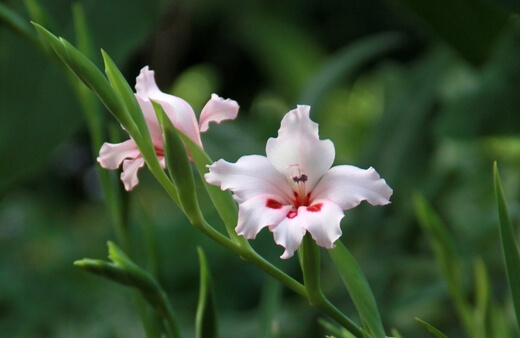 |
6. Gladiolus sericeovillosusG. sericeovillosus is a native to Zimbabwe and grows in subtropical, rather than tropical conditions. It’s ideal for slightly cooler gardens or spaces where full sun is hard to come by, but still prefers moist soil and bright light where possible. Its flowers are subtler than most species of gladioli, but with a mystique that drops jaws. The delicately spotted pink-white flowers are speckled with rich burgundy, leading pollinators down the flower funnel to a verdant green cave, packed with pollen, and rich in scent. | 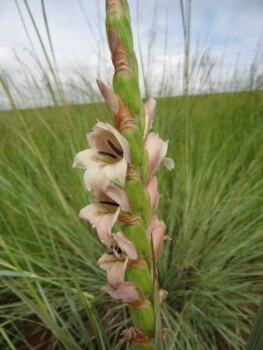 Source: pacificbulbsociety.org |
7. Gladiolus ‘Black Star’Black is always a sign that humans have intervened in nature, as an impossible colour in the floral kingdom, and even then, it’s never quite a true black. Gladiolus ‘Black Star’ is revered for its dark blooms, with streaks of gold across each primary petal that add to the illusion of this other-worldly flower. With tall spikes of over 1m tall, and deep green stems and foliage, there are few more striking ornamental plants to add to a herbaceous border. |  Source: gardenia.net |
8. Gladiolus palustrisThere are a few subtle cultivars of Gladiolus palustris, but the true species variety is the one that will always steal hearts. Coveted by collectors, G. palustris has intensely powerful, Barbie pink flowers, with twinned white streaks on the basal petal, flanked by dropping pink wings to attract pollinators from all directions. The flowers form more loosely on the stem, and grow best in moist or even damp conditions, giving it its common name, the marsh gladiolus. |  |
9. Gladiolus ‘Blood Red Sword’As the name suggests, Gladiolus ‘Blood Red Sword’ is an insanely vivid, deep crimson flower, standing on tall, compact spikes, which fan out from the centre of each plant to curate a showy display that rages out for the green backdrop of any perennial border. | Cell |
10. Gladiolus ‘Apricot Perfection’There are still swathes of gardeners who disagree with yellow in planting schemes. There’s something about the shades of yellow which planted on mass can look like weeds I guess. However, some more subtle shades of yellow, and apricot oranges, in particular, can add a gentle summery lift to any garden. The elegant apricot flower spikes of Gladiolus ‘Apricot Perfection’ would stand out in a container, just as much as a border, so are ideal for a quick spring planting plant, ready for summer flowers. | Cell |
1. Gladiolus ‘Black Pearls’

Source: commons.wikimedia.org
As well as being reliably tall, and flowering for longer than most gladiolus, Black Pearl has gorgeous burgundy flowers, and often up to three huge flower spikes per plant, which bloom together, and can be extended by deadheading.
If you can fit such rich colour into your borders without it clashing, there is no better, or easier gladiolus to grow.
2. Gladiolus alatus

Source: en.wikipedia.org
Gladiolus alatus is a true species of gladiolus, found naturally in South Africa on the Cape Peninsula, where it benefits from sea breezes and hot summers, growing freely in grasslands.
Its deep, zesty, orange petals stand proudly over an acid-yellow basal petal to attract bees and pollinators to its open blooms.
3. Gladiolus communis subsp. byzantinus

Source: southernbulbs.com
The violet petals of G. communis subsp. byzantinus pop even brighter thanks to the silvery foliage and delicate stems, which raise these glorious blooms well above the rest of the garden, floating perfectly when nestled in amongst a frothy backdrop of Verbena bonariensis.
4. Gladiolus ‘Priscilla’

Source: gardenexpress.com.au
As one of the most popular Gladioli cultivars, Priscilla has an obvious blousiness that is often associated with the gardens of the 1980s. For me though, that nostalgia adds to its charm, with creamy blooms, tipped with a delicate jammy pink, and a sugary yellow centre to each flower. It would challenge any gardener not to salivate at the sight of these luxurious blooms.
5. Gladiolus ‘Painted Lady’

I can’t think of a genus of flowering plants without a variety called painted lady. And while the name might be more synonymous with Sweet Peas, it is rarely more accurately applied than with Gladiolus ‘Painted Lady’.
The crisp white flowers have a powdery red detail across each petal, forming star-shaped blooms that develop in stages along each stem. Plus, each plant can have up to ten spikes, making it a great option for quick instant-impact planting.
6. Gladiolus sericeovillosus

Source: pacificbulbsociety.org
G. sericeovillosus is a native to Zimbabwe and grows in subtropical, rather than tropical conditions. It’s ideal for slightly cooler gardens or spaces where full sun is hard to come by, but still prefers moist soil and bright light where possible.
Its flowers are subtler than most species of gladioli, but with a mystique that drops jaws. The delicately spotted pink-white flowers are speckled with rich burgundy, leading pollinators down the flower funnel to a verdant green cave, packed with pollen, and rich in scent.
7. Gladiolus ‘Black Star’

Source: gardenia.net
Black is always a sign that humans have intervened in nature, as an impossible colour in the floral kingdom, and even then, it’s never quite a true black. Gladiolus ‘Black Star’ is revered for its dark blooms, with streaks of gold across each primary petal that add to the illusion of this other-worldly flower.
With tall spikes of over 1m tall, and deep green stems and foliage, there are few more striking ornamental plants to add to a herbaceous border.
8. Gladiolus palustris

There are a few subtle cultivars of Gladiolus palustris, but the true species variety is the one that will always steal hearts. Coveted by collectors, G. palustris has intensely powerful, Barbie pink flowers, with twinned white streaks on the basal petal, flanked by dropping pink wings to attract pollinators from all directions.
The flowers form more loosely on the stem, and grow best in moist or even damp conditions, giving it its common name, the marsh gladiolus.
9. Gladiolus ‘Blood Red Sword’
As the name suggests, Gladiolus ‘Blood Red Sword’ is an insanely vivid, deep crimson flower, standing on tall, compact spikes, which fan out from the centre of each plant to curate a showy display that rages out for the green backdrop of any perennial border.
10. Gladiolus ‘Apricot Perfection’
There are still swathes of gardeners who disagree with yellow in planting schemes. There’s something about the shades of yellow which planted on mass can look like weeds I guess. However, some more subtle shades of yellow, and apricot oranges, in particular, can add a gentle summery lift to any garden.
The elegant apricot flower spikes of Gladiolus ‘Apricot Perfection’ would stand out in a container, just as much as a border, so are ideal for a quick spring planting plant, ready for summer flowers.
How to Grow Gladiolus in Australia
Gladioli need full sun, and despite growing in nearly arid conditions in their native environment, grow well in moist, but reasonably drained soils. Avoid clay, and add plenty of compost before planting, and you should be rewarded by dramatic blooms in summer.
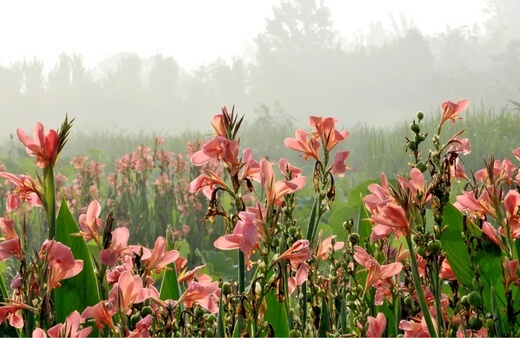
Follow our planting guide below to get the most from your gladioli corms:
Planting Gladiolus
Gladioli corms are available to buy from fall to spring, but must be kept dry, and never planted when there is a risk of frost in their first few weeks. Planting corms in autumn has some risk of winter loss, but they are frost-hardy plants, and will usually grow stronger in spring from a fall planting.
However, the safest time to plant gladioli corms is in spring, or late winter, when they can start growing immediately. They may flower later in their first year, but you’ll be guaranteed a bright display in years to come, particularly as the corms replace themselves as each plant fades.
Plant gladioli corms at a depth of 5-10cm deep. Follow the basic rule of bulb planting, using three times the depth of the corm as a guide, with a little extra to provide stability for their tall summer stems.
Light
Gladiolus plants need full sun. Dappled shade will be ok, but they perform at their best when they are faced with bright summer heat and will flower more dramatically as a result.
Most Australian gardens will have no trouble finding bright light, but if you can’t find a spot in full sun, plant gladiolus against a bright, white, reflective wall, where it will benefit from the reflected heat and light.
Watering Schedule
Gladiolus might like arid conditions, but they perform better in gardens when watered regularly and fed to increase their vegetative (green) growth before the flower season begins.
Watering over well drained soil helps to improve overall plant health, and supports architectural foliage before and after the flowers have bloomed.
Best Soil for Sword Lily
Gladioli need slightly acidic soil, but most average garden soils have a reasonable pH for gladioli. More importantly, try to feed them gently, either with a bulb compost mixed through the soil (which will improve drainage), or a standard garden compost (which will boost nutrients and add some water retention to sandy soils).
Growing Gladiolus in Pots

One surefire way to create easily manageable gladioli for cut flower displays is by growing them in pots. They will spread in their containers, and in southern Australia they can be moved indoors or into a garage over winter to protect them from severe frosts, leading to earlier displays the following year.
To grow gladioli in pots, plant corms at three times their depth, in well-drained compost, and add a few support around the edge in preparation for their tall foliage and heavy flower spikes.
Space corms 1-2” apart, and feed them well to support the denser growing conditions, or plant them at 4-5” apart to allow for more natural conditions, with more vigorous plants with fewer flowers.
How to Propagate Sword Lily
There are three easy ways to grow gladioli and are fairly straight forwards. Growing gladioli from corms can be expensive (usually about $10 for a bag or summer bulbs), but growing them from seed or divided existing plants costs next to nothing.
Propagating Gladiolus from Seeds
Gladioli seeds are readily available online and in garden centres most springs, and should be planted in early summer to develop corms that flower the following year. Start your gladioli in seed trays by sowing seeds directly onto the surface of seed compost, and soaking the soil.
Leave the tray somewhere bright, but away from direct sunlight for 1-2 months. After germination, prick seedlings out when they are large enough to handle, and grow them in individual pots through summer, fall and winter.
The following spring, if they have developed a decent root system and/or corms, plant those into the garden where you want them to stay. Most gladioli planted from seed will flower in their second year, but some varieties can take an extra year to flower.
Don’t worry though, the foliage alone is worth growing them, and patience, as we know, is a virtue in the garden.

Propagating Gladioli from Division
Like any herbaceous perennial from corms, tubers, rhizomes, or bulbs, gladiolus spreads and develops new corms alongside the original plant. This makes growing new plants incredibly easy, but also tends to create hollow spaces around the original planting spot.
Because gladioli only live for 4-5 years, they naturally replace themselves in good conditions. When this happens, you can simply dig up clumps of corms in spring (easy to spot as the foliage will be bursting through the soil in compact spikes).
Dig the clumps out, and plant them immediately in a new location.
For gladiolus in pots, if the centre has hollowed out, but new foliage is showing around the edge, simply split the clump in half, and flip it in on itself, so the foliage is at the centre and the faded bulbs are around the outside. This creates a more natural shape and allows the empty space to be filled again.
How to Save Gladioli Corms
The best time to plant gladiolus corms is in spring, so if you intend to save corms from the ground to grow new plants from next year, it’s worth drying them and storing them, rather than planting them directly in late summer, fall or winter.
Dig up clumps of gladiolus after flowering has finished, and you’ll notice clusters of tiny corms. These are ready to flower next year. All you have to do is leave them to dry, then shake off any soil.
Leave them to dry on a rack in a cool, dark place, then pop them in a paper bag and keep it dry and dark until early spring.
Caring for Gladiolus
Once established, and growing well, gladioli are quite high-maintenance plants. They require staking, but with enough space to rock in the wind. This means giving each plant at least three stakes, or creating a weave through clumps to prevent the stems from snapping under the heavy weight of their flowers.
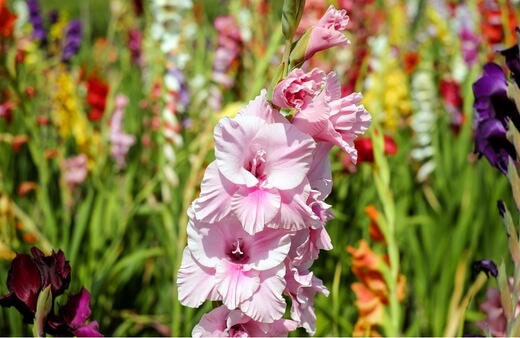
This is more important for more blousy gladiolus flowers, but still worth doing for the more delicate varieties.
Staking Gladiolus
To stake a single gladiolus, push three 3-4ft bamboo stakes into the soil around each plant. Tie twine in a ring around the bamboo, so each plant has a limit to how far it can rock. This helps to reinforce the strength of the foliage, which hems in the flower spikes.
For clumps of gladiolus, one time-saving hack is to push bamboo stakes into the ground all the way around the clump, and weave twine from one stake to another, until you have a loose mesh of twine through the plants. This gives some structure and is less visible than other methods.
Read our complete guide and find out more about garden staking and its different methods.
Mulching Gladioli
Gladioli, like any herbaceous perennial, love a good mulch in spring. Avoid mulching in winter as this can promote moisture retention through winter, and rot the corms.
In spring, mulch around emerging foliage with well-rotted manure or garden compost to provide a healthy organic nutrient boost.
What Fertiliser to Use
Gladioli need a balanced feed as they are grown in equal measure for their foliage and flower. Tomato fertilisers are a good option, as is liquid seaweed (dried seaweed can be used as a mulch) or compost tea.
Soak nettles or comfrey in water for a month until you have a smelly mush or wet leaves. The concentrated nutrients in the remaining liquid can be mixed into a watering can boost nutrients.
Gladioli Pests and Diseases to Watch For
Part of the reason that blousy blooms went out of fashion in the early 2000s was a drive towards low-maintenance gardens where pests and diseases didn’t affect plants, and gardeners had less to worry about.
However, gardeners are quickly realising that it’s a compromise not worth making. Sometimes, you need to do the work to get the reward, and in the case of gladioli, that means pest control!
Gladiolus thrips
All thrips can affect gladioli, but there is a particular species, the Gladiolus thrip particularly seeks out these verdant plants, with fast-growing leaves packed with nutrients and chlorophyll.
Thrips are tiny brown insects and can be hard to spot, but if you see black dots covering the foliage of a gladiolus it is likely to be their excrement and a clear sign of thrips infestation.
Thrips tend to hide around leaf nodes, and under fresh buds where they feed on the young plant tissue and distort the development of flowers and leaves. Thrips can be blasted off with a garden hose, or treated with organic sprays like neem oil.
Having a good garden hose nozzle will do wonders to your plants so be sure to check our review of the best hose nozzles available in Australia.
Caterpillars
Caterpillars love the nutrient-packed foliage of gladiolus and moths often lay eggs on gladiolus as there are many nooks to hide in. Regularly eaten leaves are a clear sign of caterpillar damage, and the best way to get rid of them is to pick them off by hand.
If you’ve got a good population of garden birds, place caterpillars on the bird table, and they’ll be coming back for more.
Two spotted spider mites
Spider mites, two spotted ones, in particular, love gladiolus because of its growing conditions, more than the plant itself. Spider mites thrive in dry, hot conditions, and are commonly found on houseplants for similar reasons.
Spider mite damage usually appears at first as tiny orange dots on the surface of leaves. If you turn the leaf over you’ll notice corresponding black or brown dots.
These are the beginnings of fungal infections caused by irregular leaf damage. Spider mites should be treated with neem oil, but will also reduce or move on if you water your plants more as they display damp conditions.
Gladiolus, as we’ve explored, are sun-loving plants from arid regions around the world. Growing them in our gardens means asking them to cope with wetter conditions, and different soils, often with native pests thrown into the mix. This does make them quite prone to common diseases like rust, blight, and fusarium rot.
Rust
Rust affects most sturdy leaf bulb and corm plants in equal measure. If you have a veggie garden you’ll probably have experienced rust on your leeks or onions too. The same virus can spread to gladiolus and is passed through infected compost, insects, and dirty tools.
Rust is a spotted orange covering across foliage and is really difficult to manage. You can treat it with organic fungicides to limit the problem, but the safest bet is to remove the affected plants and burn them before treating the soil with an organic fungicide and flushing it through with water.
Botrytis rot
Botrytis rot can affect leaves, stems, flowers, and corms on gladiolus. The same botrytis fungus that affect tomatoes, onions, potatoes, and dahlias is equally potent against gladiolus so treat it with a fungicide or remove the affected areas.
To spot botrytis in stems, look out for brown or black lesions on foliage. If the foliage appears yellow, wilting, and lacklustre, check the corms. If they are black, mushy, or have an unpleasant odour, remove them and burn them (or bin them) so the problem doesn’t spread to other plants.
Storage rot
Storage rot is a problem that affects corms, not plants. If you have dried corms in the garage or shed it’s essential to keep them cool, dark, and dry. Heat, moisture, and light can lead them to begin growing and pulling in moisture from the surrounding environment.
In storage this creates humidity, and if one corm rots, it will infect the others. There are various fungal pathogens which cause this, but fundamentally, treatment is prevention. Check corms regularly, and remove any damp or mushy corms.
Gladiolus Frequently Asked Questions

Do gladiolus come back every year?
Gladioli come back every year but are fairly short-lived in terms of peak performance. After 3-4 years, consider lifting old plants to allow new plants to colonise the area naturally, or replanting new corms for a fuller display.
What is the best time to plant gladiolus corms?
Plant gladiolus bulbs at the very start of spring for a long growing season, and less risk of frost damage. While gladiolus corms can cope with frost, they should be protected from extreme weather before they begin to grow.
In very cold regions, they should be lifted and stored indoors before planting out again in spring.
When do gladioli flower?
Gladioli flower in early summer, even late spring in some parts of the country, usually for around four weeks. Gladiolus can flower through summer and into fall with regular deadheading, but hotter climates tend to limit the flowering window and exhaust the plant.
When should you cut back gladiolus foliage?
Cut back gladiolus foliage after it has completely died back. Like bulbs, the foliage helps to feed the corms below ground. As the foliage dies back the nutrients are reabsorbed by the corms to provide energy for the following spring, before the plant goes dormant over winter. Once the foliage has turned brown, cut it all back and compost it.
Grow Beautiful Gladiolus in Your Garden
As far as blousy garden blooms go, it’s hard to beat gladiolus. Their reliable flower spikes and bright, varied, displays make them an ideal addition for any cottage garden planting scheme, but they work equally well amongst tropical planting for a more unusual pop of colour.
Once you’re used to staking and supporting gladiolus plants they are super simple to care for. If you have time this winter, prepare a bed with fresh compost, ready to grow a wealth of gladiolus corms in spring and completely transform your garden.
Published on October 18, 2022 by Maisie Blevins
Last Updated on February 22, 2024





We are moving house in Dec ( Australia), I would like to take my Gladies and want to know if they can miss a year of planting.
Thank you in advance
Hi Belinda,
I get asked this so often, and not just about Gladioli. It’s tricky to store corms well, but it can be done. There are some specialist conservation centres that hold bulbs and corms back for years at a time even. In terms of home storage though, twelve months is about the maximum you can go without planting them out, but hopefully that fits the bill for your house move!
Just make sure they’re stored somewhere cool (between 5°C and 10°C) and dry (humidity below 50% if possible – humidity sensors are super cheap online), and any natural light is completely blocked.
In winter, keep them above freezing too, because thawing dormant corms can rot them. By far the most important thing though is to keep them apart. You’re bound to lose one or two corms from bacteria they’ve already been in contact with, so to stop that rot spreading, wrap each bulb in dry newspaper, and check them once a month to remove any that go bad.
Plant them out when you’ve got the new garden ready, and they should flower away happily. Or, the much easier route… just plant them in pots packed with free-draining compost and keep them out of the way. That way they’ll flower and multiply as normal, and you’ll have extra to plant the next year.
Best regards,
Gary Clarke
Thank you so much for your wonderfully detailed response to my question. I have spent the morning planting my Gladioli, your advice made very good sense.
Many thanks once again. Looking forward to seeing my flowers this year.
Regards,
Belinda M.